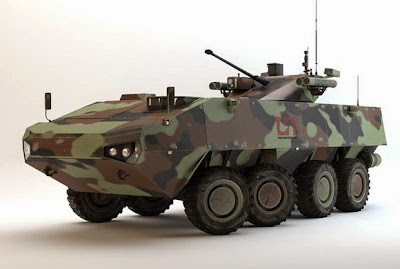Russia's rearmament program will see the replacement of the iconic Soviet BTR-80 with a new armored personnel carrier known as the Boomerang.
The Boomerang is still about two years away from serial production, but it will take part in this year's May 9 parade.
Recently a new family of 8x8 armored vehicles was developed in Russia. The project is known as the Bumerang (boomerang). A baseline vehicle is an armored personnel carrier. The new APC was revealed to Russian military officials in 2013. The whole project is being kept in high secrecy. It is being developed alongside a new-generation Kurganets-25 infantry fighting vehicle. First APCs were delivered to the Russian Army for trials and evaluation in 2013. The Bumerang was first publicly revealed in 2015. Once approved, full-scale production is expected to begin in 2015.
Once operational this new-generation APC should replace a whole host of ageing Russian armored vehicles. The estimated requirement is at least 2 000 vehicles.
In the early 90s the BTR-90 was developed in Russia. It had a more powerful armament, improved protection greater mobility and increased internal volume, comparing with the previous BTR-80. However it was not accepted to service with the Russian Army, possibly due to funding problems. Since 2010 Russia stopped purchasing the older BTR-80 APCs. Currently improved BTR-82 is being obtained as a stop-gap measure until a new vehicle is available. In 2011 Russian MoD issued a requirement for a modular family of armored vehicles instead of the BTR-90.
The new vehicle has modular design. It has been reported that a number of components and subsystems are interchangeable with Kurganets-25 infantry fighting vehicle.
Engine of the Bumerang is located at the front of the hull. Troops will leave the new vehicle via rear doors, or roof hatches. It is worth mentioning that a rear-mounted engine of the BTR series APCs was a significant drawback, as troops had to leave the vehicle via side doors. Cramped side entry and exit hatches are even worse on BTR-70 APCs, which is still in service with the Russian Army. If such vehicle is ambushed, troops usually have to leave it under direct enemy fire.
It is most likely that the Bumerang will have a crew of three, including commander, gunner and driver. It will carry around 7 soldiers.
The new armored personnel carrier will be fitted with remotely controlled weapon station. Various stations are being developed, armed with 30-mm cannon, 12.7-mm and 7.62-mm machine guns. Vehicle might be also fitted with anti-tank guided missile launchers.
The new APC will have an 8x8 configuration. It will be fitted with a turbocharged diesel engine, developing around 500 hp. The same engine will be also used on Kurganets-25 next-generation infantry fighting vehicle. It seems that the new vehicle will be fully amphibious. On water it will be propelled by two waterjets.
Other armored vehicles of the Bumerang family will include armored ambulance, command post vehicle, reconnaissance vehicle, anti-tank missile carrier, air defense missile launcher, fire support vehicle, mortar carrier, and other. It seems that with these vehicle Russia plans to equip rapid deployment brigades, similar to US Stryker brigades.
| Entered service | expected in 2015 |
| Crew | 3 men |
| Personnel | ~ 7 men |
| Dimensions and weight | |
| Weight | 15 ~ 20 t |
| Length | ~ 8 m |
| Width | ~ 3 m |
| Height | ~ 3 m |
| Armament | |
| Main gun | 30-mm (?) |
| ATGW | Kornet-EM (?) |
| Machine guns | 1 x 7.62-mm (?) |
| Ammunition load | |
| Main gun | 500 rounds (?) |
| ATGW | 4 missiles (?) |
| Machine guns | 2000 x 7.62-mm (?) |
| Mobility | |
| Engine | diesel |
| Engine power | ~ 500 hp |
| Maximum road speed | ~ 100 km/h |
| Amphibious speed on water | ~ 10 km/h |
| Range | ~ 800 km |
| Maneuverability | |
| Gradient | 60% |
| Side slope | 40% |
| Vertical step | ~ 0.6 m |
| Trench | ~ 2 m |
| Fording | Amphibious |










